|
|
 |
| Spacecraft |
 |
02-Aug-2007
|
View Related
Martian Terrain Images
|
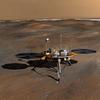 |
Instruments on Phoenix Mars Lander
NASA's Phoenix Mars Lander uses its Meteorological Station and its Robotic Arm at the same time in this artist's concept of the spacecraft on the surface of Mars.
The other instruments in the spacecraft's science payload are the Surface Stereoscopic Imager; the Microscopy, Electrochemistry, and Conductivity Analyzer; the Thermal and Evolved-Gas Analyzer; the Mars Descent Imager; and the Robotic Arm Camera.
A vertical green line in this illustration shows how the Meteorological Station on Phoenix will use a laser beam from a lidar instrument to monitor dust and clouds in the atmosphere. The dark "wings" to either side of the lander's main body are solar panels for providing electric power.
Image credit: NASA/JPL-Caltech/UA/Lockheed Martin
|
Unlabeled |
|
Browse Image |
Medium Image (102 kB) |
Large (4.2 MB)
|
Labeled |
|
Browse Image |
Medium Image (65 kB) |
Large (85 kB)
|
|
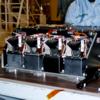 |
Chemistry Lab for Phoenix Mars Lander
The science payload of NASA's Phoenix Mars Lander includes a multi-tool instrument named the Microscopy, Electrochemistry, and Conductivity Analyzer (MECA). The instrument's wet chemistry laboratory, prominent in this photograph, will measure a range of chemical properties of Martian soil samples, such as the presence of dissolved salts and the level of acidity or alkalinity. Other tools that are parts of the instrument are microscopes that will examine samples' mineral grains and a probe that will check the soil's thermal and electrical properties.
Image credit: NASA/JPL-Caltech/UA
|
Browse Image |
Medium Image (122 kB) |
Large (154 kB)
Full Resolution (3.4 MB)
|
|
|
|
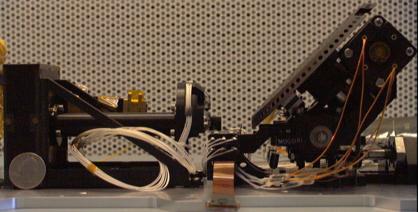 |
Microscopes for NASA's Phoenix Mars Lander
One part of the Microscopy, Electrochemistry, and Conductivity Analyzer instrument for NASA's Phoenix Mars Lander is a pair of telescopes with a special wheel (on the right in this photograph) for presenting samples to be inspected with the microscopes. A horizontally mounted optical microscope (on the left in this photograph) and an atomic force microscope will examine soil particles and possibly ice particles.
The shapes and the size distributions of soil particles may tell scientists about environmental conditions the material has experienced. Tumbling rounds the edges. Repeated wetting and freezing causes cracking. Clay minerals formed during long exposure to water have distinctive, platy particles shapes.
Image credit: NASA/JPL-Caltech/UA
|
Browse Image |
Medium Image (161 kB) |
Large (164 kB)
Full Resolution (3.3 MB)
|
|
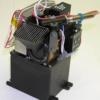 |
Phoenix Mars Lander's Chemistry Lab in a Box
The wet chemistry laboratory on NASA's Phoenix Mars Lander has four teacup-size beakers. This photograph shows one of them. The laboratory is part of the spacecraft's Microscopy, Electrochemistry and Conductivity Analyzer.
Each beaker will be used only once, for assessing soluble chemicals in a sample of Martian soil by mixing water with the sample to a soupy consistency and keeping it warm enough to remain liquid during the analysis.
On the inner surface of the beaker are 26 sensors, mostly electrodes behind selectively permeable membranes or gels. Some sensors will give information about the acidity or alkalinity of the soil sample. Others will gauge concentrations of such ions as chlorides, bromides, magnesium, calcium and potassium. Comparisons of the concentrations of water-soluble ions in soil samples from different depths below the surface of the landing site may provide clues to the history of the water in the soil.
Image credit: NASA/JPL-Caltech/UA
|
Browse Image |
Medium Image (34 kB) |
Large (33 kB)
Full Resolution (606 kB)
|
|
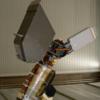 |
Thermal and Electrical Conductivity Probe for Phoenix Mars Lander
NASA's Phoenix Mars Lander will assess how heat and electricity move through Martian soil from one spike or needle to another of a four-spike electronic fork that will be pushed into the soil at different stages of digging by the lander's Robotic Arm.
The four-spike tool, called the thermal and electrical conductivity probe, is in the middle-right of this photo, mounted near the end of the arm near the lander's scoop (upper left).
In one type of experiment with this tool, a pulse of heat will be put into one spike, and the rate at which the temperature rises on the nearby spike will be recorded, along with the rate at which the heated spike cools. A little bit of ice can make a big difference in how well soil conducts heat. Similarly, soil's electrical conductivity -- also tested with this tool -- is a sensitive indicator of moisture in the soil.
This device adapts technology used in soil-moisture gauges for irrigation-control systems. The conductivity probe has an additional role besides soil analysis. It will serve as a hunidity sensor when held in the air.
Image credit: NASA/JPL-Caltech/UA
|
Browse Image |
Medium Image (24 kB) |
Large (24 kB)
Full Resolution (506 kB)
|
|
 |
Working End of Robotic Arm on Phoenix
This illustration shows some of the components on and near the end of the robotic arm on NASA's Phoenix Mars Lander. Primary and secondary blades on the scoop will aid in the collection of soil samples. A powered rasp will allow the arm to sample an icy layer expected to be about as hard as concrete. The thermal and electrical conductivity probe, which is one part of the Microscopy, Electrochemistry and Conductivity Analyzer, will assess how heat and electrons move through the soil from one spike to another of a four-spike electronic fork that will be pushed into the soil at different stages of digging by the arm.
Image credit: NASA/JPL-Caltech
|
Labeled |
|
Browse Image |
Medium Image (31 kB) |
Large (46 kB)
|
Unlabeled |
|
Browse Image |
Medium Image (22 kB) |
Large (72 kB)
|
|
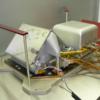 |
Thermal and Evolved-Gas Analyzer for Phoenix Mars Lander
NASA's Phoenix Mars Lander carries an instrument to heat and sniff samples of Martian soil and ice to analyze some ingredients.
The Thermal and Evolved-Gas Analyzer will study substances that are converted to gases by heating samples delivered to this instrument by the lander's robotic arm. It provides two types of information. One of its tools, called a differential scanning calorimeter (on the left in this photograph) monitors how much power is required to increase the temperature of the sample at a constant rate. This reveals which temperatures are transition points from solid to liquid and from liquid to gas for ingredients in the sample. The gases that are released, or "evolved" by this heating then go to a mass spectrometer (on the right), a tool that can identify the chemicals.
Image credit: NASA/JPL-Caltech/UA
|
Browse Image |
Medium Image (107 kB) |
Large (214 kB)
Full Resolution (5.9 MB)
|
|
JPL Image Use Policy
|